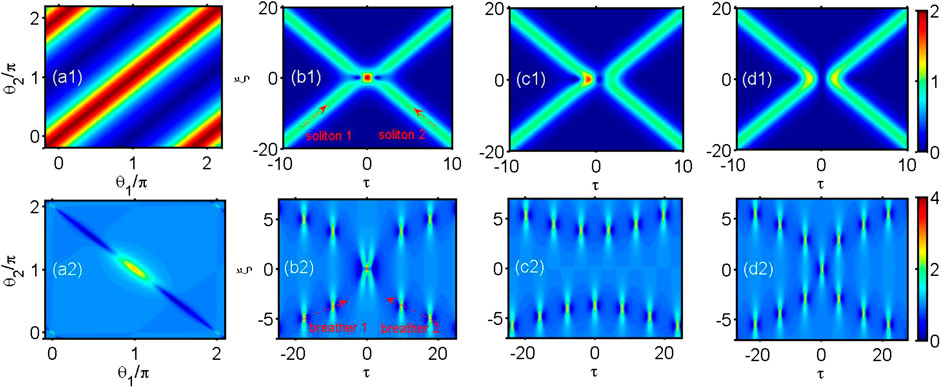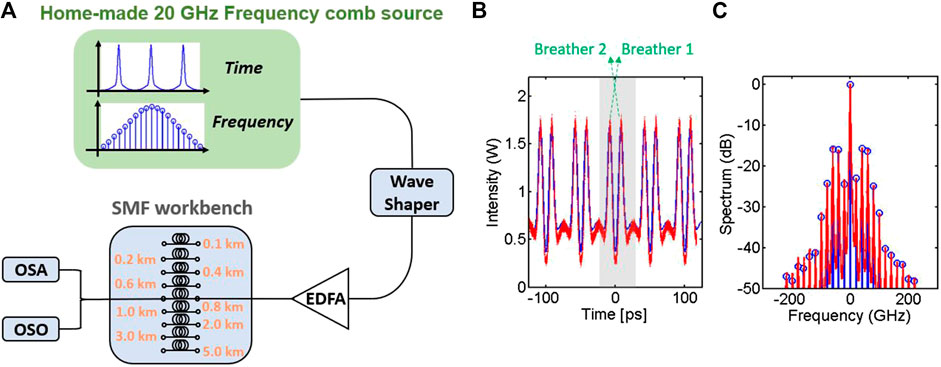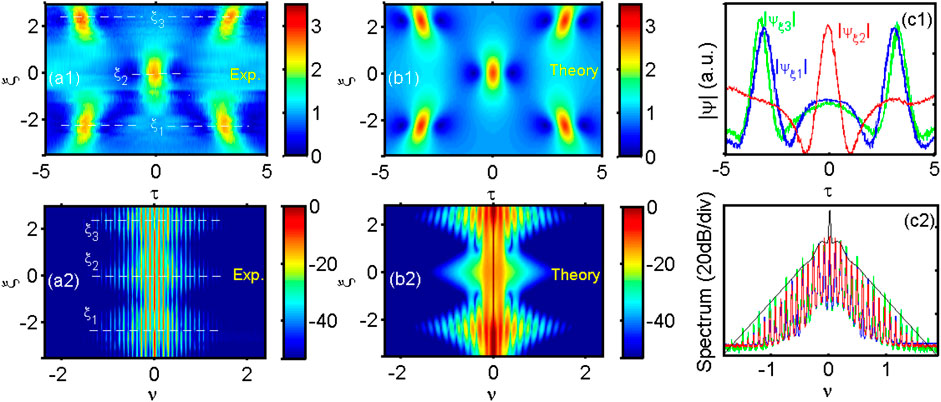
94% of researchers rate our articles as excellent or good
Learn more about the work of our research integrity team to safeguard the quality of each article we publish.
Find out more
BRIEF RESEARCH REPORT article
Front. Phys., 07 December 2020
Sec. Statistical and Computational Physics
Volume 8 - 2020 | https://doi.org/10.3389/fphy.2020.608894
This article is part of the Research TopicPeregrine Soliton and Breathers in Wave Physics: Achievements and PerspectivesView all 25 articles
Mutual interaction of localized nonlinear waves, e.g., solitons and modulation instability patterns, is a fascinating and intensively-studied topic of nonlinear science. Here we report the observation of a novel type of breather interaction in telecommunication optical fibers, in which two identical breathers propagate with opposite group velocities. Under controlled conditions, neither amplification nor annihilation occurs at the collision point and most interestingly, the respective envelope amplitude, resulting from the interaction, almost equals another envelope maximum of either oscillating and counterpropagating breather. This ghost-like breather interaction dynamics is fully described by an N-breather solution of the nonlinear Schrödinger equation.
The study of both, formation and interaction of localized waves has been a central task in nonlinear physics during the last decades, including plasma physics, fluid dynamics, Bose-Einstein condensates and photonics. Among different types of nonlinear localized waves, solitons are the most representative and ideal testbed to investigate nonlinear wave interactions due to their intrinsic particle-like properties during propagation [1–4]. A generic and relevant case of study for various fields of research is the elastic and nonlinear interaction of envelope solitons, which can be described by the focusing one-dimensional nonlinear Schrödinger equation (NLSE). In this conservative and integrable system, the possible collision of solitons with different velocities does not affect their shape or velocity after interaction, and their main physical properties keep unchanged. In general, the interaction-induced displacement in position and phase shift are independent on the relative phases of the envelope solitons. However, collision dynamics in the interaction region strongly depends on the relative phases. Consequently, in the simplest case of two-soliton collision with opposite velocities, as shown in Figures 1A1–D1 the two solitons appear to attract with each other and cross (forming a transient peak) in the in-phase configuration, while they seem to repel each other and as such stay apart in the out-of-phase case. The wave magnitude at the central point of collision then evolves from the sum of the two solitons’ amplitudes (i.e., amplification) to their difference (i.e., annihilation), respectively. A large range of theoretical descriptions, numerical simulations and experimental observations of such soliton interactions and their possible synchronization have been reported earlier [5–12].

FIGURE 1. Typical temporal evolution of soliton-pair interaction (first line) and breather-pair interaction (second line). (A1) Dependence of amplitude at the soliton collision point
Besides solitons, breather solutions of the NLSE are also exciting examples to investigate nonlinear wave interactions because of the salient complexities of breather synchronization in relation to their self-oscillating properties. From this point of view, phase-sensitive breather interactions are now widely studied [13–22]. More particularly, for co-propagative breathers, breather molecules can be formed when group velocity and temporal phase of breathers are perfectly synchronized, while for counter-propagating breathers, the phase-sensitive collision process exhibits various dynamical behaviors. Two of them have been studied in detail in the context of rogue wave formation, namely amplification and annihilation cases that resemble soliton collisions. The above interactions are fully described by N-breather solutions of the NLSE [16, 18]. However, the two-breather collision has been recently found to provide a peculiar third configuration for particular phases, neither of the above-mentioned cases, the later leads to a peak amplitude at the central point of collision equivalent to the single breather amplitude before or after the collision. Phenomenologically, it seems that one breather mysteriously disappears in the nonlinear interaction region, but it then appears after that. That is why this intriguing breather interaction was vividly termed by “ghost interaction” [19]. Its generalization to the N-breather interaction is still under investigation. However, both, detailed analysis and experimental confirmation of this remarkable dynamics for the simplest two-breather collision are still to emerge into light.
To address this scientific gap, we present the observation of ghost interaction of two breathers in a single-pass telecommunication optical fiber experiment. By means of the Fourier-transform pulse shaping technique applied to an optical frequency comb, we generate the initial condition for two counter-propagating breathers with desired temporal phases. The experimental results are in excellent agreement with the exact two-breather solution of the NLSE. We confirm that this peculiar phase-sensitive breather interaction is strictly different to the well-known soliton interactions. Our study paves the way for novel directions of investigation in the rich landscape of complex nonlinear wave dynamics [23–26].
Our theoretical framework and starting point is based on the dimensionless form of the self-focusing 1D-NLSE:
where subscripts stand for partial differentiations. Here,
where
and
In these expressions,
with
The parameters
Figures 1A2–D2 presents the interaction of a pair of counter-propagating breathers when
We emphasize that such ghost interaction of breathers as illustrated in Figure 1D2 cannot occur for the soliton counterpart (see Figures 1A1–D1). To clarify this point, we compare systematically the phase-dependent soliton collision and the phase-dependent breather collision. Similarly, we consider a pair of counter-propagating solitons with the amplitudes
In this expression,
Again, the
In order to validate these theoretical predictions with respect to ghost interaction of breathers, we have performed experiments with light waves propagating in high-speed telecommunication-grade components, as depicted in Figure 2. The main challenge here is the arbitrary wave shaping to establish the specific initial excitation of counter-propagating breathers with desired phases in the

FIGURE 2. Experimental setup and generation of initial conditions. (A) Schematic diagram of the experimental setup. EDFA: erbium-doped fiber amplification; SMF: single mode fiber; OSA: optical spectral analyzer; OSO: optical sampling oscilloscope. Shaded-green box represents the home-made frequency comb source with a repetition rate of 20 GHz. (B–C) Designed initial conditions at 20 GHz repetition rate for a pair of contra-propagative breathers in both temporal and spectral domains. Solid blue lines are theoretical curves; Solid red lines are experimental measurements. Here breather parameters are:
To this end, a 20 GHz optical frequency comb passes through a programmable optical filter (wave-shaper) to precisely control both amplitude and phase characteristics of each comb line. As a result, we can synthesize any arbitrary perturbation of a continuous wave background in a time-periodic pattern whose frequency is equal to the comb spacing. This temporal pattern is then amplified by erbium-doped fiber amplifier (EDFA) to achieve the exact excitation of the two-breather solution in terms of average power for nonlinear propagation into our single-mode optical fiber (SMF). The corresponding temporal and spectral power profiles of the light-wave are presented in Figures 2B–C. Note that the initial condition for the breather pair is time-periodic with a period of
We present our experimental results on the nonlinear space-time evolution of the breather pair studied in the above theoretical section, for the specific temporal phases
Figures 3A1–A2 presents the concatenation of temporal (amplitude) profiles and power spectra which were recorded at the output of the distinct fiber segments with increasing length. The careful control of phases allows to observe the ghost interaction between the counter-propagating breathers. The full space-time dynamics is indeed in excellent agreement with theory shown in Figures 3B1–B2. We can notice the five mains peaks appearing during the whole evolution studied in Figure 3A1: two peaks at

FIGURE 3. Experimental observation of ghost interaction of two breathers. Color maps showing the evolution of temporal amplitude (A1) and power spectrum (A2) for the two breathers observed in experiment. Dashed white lines indicate the position of local maximum amplitudes, which are also the position of largest spectral broadenings, before collision (
As shown above, during the ghost interaction of two breathers, only a single breather peak remains occurrent at the collision point. The reason for this intriguing phenomenon is related to the fact that there is a continuous and varying power exchange between the background and each localized perturbation all along the propagation, which is an intrinsic property of breathers. Therefore, when these two breathers nonlinearly interact near the collision point, for a given particular phase-collision-interaction, one of the breather peaks appears to be almost hidden in the background and then emerges again after the collision by following the energy conservation. Moreover, the breather pair keeps the spatial and temporal symmetry during the whole evolution. It is also worth to mention that such peculiar ghost interaction does not occur in conventional soliton-soliton collision scenarios because of the lack of pulse-background energy exchange [see Figures 1A1–D1].
In summary, we performed a systematic theoretical comparison between the phase-sensitive soliton-soliton collisions and breather-breather collisions. All different configurations are fully described by the exact N-breather solution of the NLSE. More importantly, we provided the first experimental observation of the very fascinating type of ghost interaction of breathers, which confirms our theoretical predictions. We also point out that our study is here restricted to the interaction of two identic counter-propagating breathers, while much more complicated many-body interactions of breathers with asymmetric conditions, including different amplitudes and/or oscillating frequencies, still require further investigations. Our current results concede a novel step toward the understanding of interactions between localized waves in nonlinear physics. These may naturally lead to encourage further relevant experimental studies and theoretical investigations in various fields of nonlinear wave physics.
The original contributions presented in the study are included in the article/Supplementary Material, further inquiries can be directed to the corresponding author.
All authors listed have made significant contributions to the theoretical and experimental developments, data acquisition, results interpretation and manuscript writing.
French National Research Agency (PIA2/ISITE-BFC, Grant No. ANR-15-IDEX-03, “Breathing Light” project). Theoretical part of the work was supported by Russian Science Foundation (Grant No. 19-72-30028).
The authors declare that the research was conducted in the absence of any commercial or financial relationships that could be construed as a potential conflict of interest.
2. Kivshar Y, Agrawal G. Optical solitons: from fibers to photonic crystals. London: Academic Press (2003).
3. Zabusky N, Kruskal M. Interaction of “solitons” in a collisionless plasmas and the recurrence of initial states. Phys Rev Lett (1965) 15:240. doi:10.1103/PhysRevLett.15.240
4. Stegeman G, Segev M. Optical spatial solitons and their interactions: universality and diversity. Science (1999) 286:1518. doi:10.1126/science.286.5444.1518
5. Zakharov V, Shabat A. Exact theory of two-dimensional self-focusing and one-dimensional self-modulation of wave in nonlinear media. Sov Phys JETP (1972) 34:62. Available from: http://www.jetp.ac.ru/cgi-bin/dn/e_034_01_0062.pdf (Accessed January 1972).
6. Yuen H, Lake B. Nonlinear dynamics of deep-water gravity waves. Adv Appl Mech (1982) 22:67. doi:10.1016/S0065-2156(08)70066-8
7. Gordon J. Interaction forces among solitons in optical fibers. Opt Lett (1983) 8:596. doi:10.1364/OL.8.000596
8. Mitschke F, Mollenaurer L. Experimental observation of interaction forces between solitons in optical fibers. Opt Lett (1987) 12:355. doi:10.1364/OL.12.000355
9. Islam M, Soccolich C, Gordon J. Ultrafast digital soliton logic gates. Opt Quant Electron (1992) 24:S1215. doi:10.1007/BF00624671
10. Antikainen A, Erkintalo M, Dudley J, Genty G. On the phase-dependent manifestation of optical rogue waves. Nonlinearity (2012) 25:R73. doi:10.1088/0951-7715/25/7/R73
11. Nguyen JHV, Dyke P, Luo D, Malomed BA, Hulet RG. Collisions of matter-wave solitons. Nat Phys (2014) 10:918. doi:10.1038/nphys3135
12. Sun Y-H. Soliton synchronization in the forcing nonlinear Schrodinger equation. Phys Rev E (2016) 93:052222. doi:10.1103/PhysRevE.93.052222
14. Akhmediev N, Soto-Crespo J, Ankiewicz A. Extreme waves that appear from nowhere: on the nature of rogue waves. Phys Lett (2009) 373:2137. doi:10.1016/j.physleta.2009.04.023
15. Frisquet B, Kibler B, Millot G. Collision of Akhmediev breathers in nonlinear fiber optics. Phys Rev X (2013) 3:041032. doi:10.1103/PhysRevX.3.041032
16. Zakharov V, Gelash A. Nonlinear stage of modulation instability. Phys Rev Lett (2013) 111:054101. doi:10.1103/PhysRevLett.111.054101
17. Chabchoub A, Akhmediev N. Observation of rogue wave triplets in water waves. Phys Lett (2013) 377:2590. doi:10.1016/j.physleta.2013.07.027
18. Gelash A, Zakharov V. Superregular solitonic solutions: a novel scenario for the nonlinear stage of modulation instability. Nonlinearity (2014) 27:R1. doi:10.1088/0951-7715/27/4/R1
19. Kibler B, Chabchoub A, Gelash A, Akhmediev N, Zakharov V. Superregular breathers in optics and hydrodynamics: omnipresent modulation instability beyond simple periodicity. Phys Rev X (2015) 5:041026. doi:10.1103/PhysRevX.5.041026
20. Xu G, Gelash A, Chabchoub A, Zakharov V, Kibler B. Breather wave molecules. Phys Rev Lett (2019) 122:084101. doi:10.1103/PhysRevLett.122.084101
21. Wu Y, Liu C, Yang Z, Yang W. Breather interaction properties induced by self-steepening and space-time correction. Chin Phys Lett (2020) 37:040501. doi:10.1088/0256-307X/37/4/040501
22. Gelash A. Formation of rogue waves from a locally perturbed condensate. Phys Rev E (2018) 97:022208. doi:10.1103/PhysRevE.97.022208
23. Xu G, Chabchoub A, Pelinovsky DE, Kibler B. Observation of modulation instability and rogue breathers on stationary periodic waves. Phys. Rev. Res. (2020) 2:033528. doi:10.1103/PhysRevResearch.2.033528
24. Copie F, Randoux S, Suret P. The Physics of the one-dimensional nonlinear Schrödinger equation in fiber optics: rogue waves, modulation instability and self-focusing phenomena. Rev. Phys. (2020) 5:100037. doi:10.1016/j.revip.2019.100037
25. Dudley JM, Genty G, Mussot A, Chabchoub A, Dias F. Rogue waves and analogies in optics and oceanography. Nat. Phys. Rev. (2019) 1:675. doi:10.1038/s42254-019-0100-0
26. Dudley JM, Dias F, Erkintalo M, Genty G. Instability, breathers and rogue waves in optics. Nat Photon (2014) 8:755. doi:10.1038/nphoton.2014.220
27. Kuznetsov E. On solitons in parametrically unstable plasma. Dokl Akad Nauk SSSR (1977) 236:575. Available from: http://mi.mathnet.ru/eng/dan41246 (Accessed May 2 1977).
28. Ma Y. The perturbed plan-wave solutions of the cubic Schrodinger equation. Stud Appl Math (1979) 60:43. doi:10.1002/sapm197960143
29. Peregrine D. Water waves, nonlinear Schrodinger equation and their solutions. J. Aust. Soc. Series B, Appl. Math. (1983) 25:16. doi:10.1017/S0334270000003891
30. Kibler B, Fatome J, Finot C, Millot G, Dias F, Genty G, et al. The Peregrine soliton in nonlinear fiber optics. Nat Phys (2010) 6:790. doi:10.1038/nphys1740
31. Kibler B, Fatome J, Finot C, Millot G, Genty G, Wetzel B, et al. Observation of Kuznetsov-Ma soliton dynamics in optical fiber. Sci Rep (2012) 2:463. doi:10.1038/srep00463
32. Chabchoub A, Hoffmann N, Akhmediev N. Phys Rev Lett (2011) 106:204502. doi:10.1103/PhysRevLett.106.204502
33. Bailung H, Sharma SK, Nakamura Y. Observation of Peregrine solitons in a multicomponent plasma with negative ions. Phys Rev Lett (2011) 107:255005. doi:10.1103/PhysRevLett.107.255005
34. Chabchoub A, Kibler B, Dudley JM, Akhmediev A. Hydrodynamics of periodic breathers. Phil. Trans. R. Soc. A (2014) 372:20140005. doi:10.1098/rsta.2014.0005
35. Närhi M, Wetzel B, Billet C, Toenger S, Sylvestre T, Merolla J-M, et al. Nat. Commun., Real-time measurements of spontaneous breathers and rogue wave events in optical fiber modulation instability. Nat Commun (2016) 7:13675. doi:10.1038/ncomms13675
36. Suret P, El Koussaifi R, Tikan A, Evain C, Randoux S, Szwaj C, et al. Bielawski S. Single-shot observation of optical rogue waves in integrable turbulence using time microscopy. Nat Commun (2016) 7:13136. doi:10.1038/ncomms13136
37. Xu G, Hammani K, Chabchoub A, Dudley JM, Kibler B, Finot C. Phase evolution of Peregrine-like breathers in optics and hydrodynamics. Phys Rev E (2019) 99:012207. doi:10.1103/PhysRevE.99.012207
38. Erkintalo M, Hammani K, Kibler B, Finot C, Akhmediev N, Dudley JM, et al. Genty G. Higher-order modulation instability in nonlinear fiber optics. Phys Rev Lett (2011) 107:253901. doi:10.1103/PhysRevLett.107.253901
39. Kedziora D, Ankiewicz A, Akhmediev N. Classifying the hierarchy of nonlinear-Schrodinger-equation rogue-wave solutions. Phys Rev E (2013) 88:013207. doi:10.1103/PhysRevE.88.013207
40. Kibler B, Chabchoub A, Gelash A, Akhmediev N, Zakharov V. Ubiquitous nature of modulation instability: from periodic to localized perturbations. In: Wabnitz S, editor. Nonlinear guided wave optics. Bristol: IOP Publishing (2017).
Keywords: nonlinear waves, modulation instability, breathers, solitons, nonlinear fiber optics
Citation: Xu G, Gelash A, Chabchoub A, Zakharov V and Kibler B (2020) Ghost Interaction of Breathers. Front. Phys. 8:608894. doi: 10.3389/fphy.2020.608894
Received: 22 September 2020; Accepted: 10 November 2020;
Published: 07 December 2020.
Edited by:
Manuel Asorey, University of Zaragoza, SpainReviewed by:
Haci Mehmet Baskonus, Harran University, TurkeyCopyright © 2020 Xu, Gelash, Chabchoub, Zakharov and Kibler. This is an open-access article distributed under the terms of the Creative Commons Attribution License (CC BY). The use, distribution or reproduction in other forums is permitted, provided the original author(s) and the copyright owner(s) are credited and that the original publication in this journal is cited, in accordance with accepted academic practice. No use, distribution or reproduction is permitted which does not comply with these terms.
*Correspondence: Bertrand Kibler, YmVydHJhbmQua2libGVyQHUtYm91cmdvZ25lLmZy
Disclaimer: All claims expressed in this article are solely those of the authors and do not necessarily represent those of their affiliated organizations, or those of the publisher, the editors and the reviewers. Any product that may be evaluated in this article or claim that may be made by its manufacturer is not guaranteed or endorsed by the publisher.
Research integrity at Frontiers

Learn more about the work of our research integrity team to safeguard the quality of each article we publish.